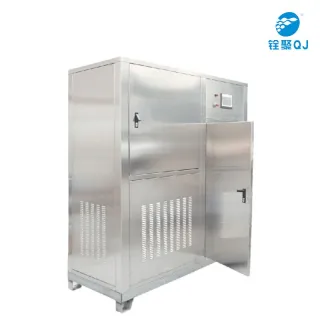Things to note when using an ozone generator
The ozone generator is a very advanced product, but there are still dangers caused by improper use, poor maintenance, material replacement, etc. Sources of danger include: oxygen, ozone, mechanical wires, electricity and air pressure, among which oxygen and ozone are more likely to cause danger.
However, when ozone is used as raw material gas, due to its characteristics of supporting combustion and accelerating combustion (especially when the content in the air is >25% by volume), if the ventilation is poor, the internal or external pipelines of the equipment leak, or the oxygen-containing system is opened, it may cause Oxygen levels rise to dangerous levels. Elevated oxygen levels increase fire hazards. For this reason, open flames are specifically prohibited, tarpaulins are not allowed, and equipment in contact with oxygen must not come into contact with oil and butter.
Ozone is a toxic and corrosive gas that can intensify combustion, is heavier than air and oxygen (can accumulate on the ground and in narrow channels), is pungent and unstable. Below are the human body reactions to ozone at various concentrations.
Therefore, special training must be provided for use and maintenance personnel; other personnel must be restricted from entering the "ozone zone" and warning signs must be hung; sufficient ventilation must be provided to indicate escape routes; emergency shutdown can be achieved in the event of danger; appropriate breathing apparatus must be prepared on site Living; conduct environmental monitoring of all places where ozone may be present.
Ozone generator usage conditions
1. Equipment installation location
The location where the ozone generator is placed should be designed with a ventilation system to ensure that the ozone generator meets the ventilation volume requirements of more than 15 times/h in emergency situations (ozone leakage). If an oxygen concentrator system is equipped, the gas volume required by the oxygen concentrator should also be considered. The ozone generating room is equipped with protective grounding, instrument grounding and drainage ditches. The ground where the machine is placed must be flat. Pay attention to placing the equipment stably on the ground or on a bracket.

2. Environmental requirements
There should be no flammable, explosive gases and conductive dust in the room. It is prohibited to install it in dangerous areas where ammonia gas is easy to leak or there is a risk of explosion. Ambient temperature requirements: 4°C ~ 40°C. The annual average relative humidity of the environment where the ozone generator works is not greater than 80%. When the relative humidity of the environment is greater than 90%, start-up should be avoided.
3.Temperature
The designed ambient temperature range of the ozone generator is 5°C ~ 40°C. This temperature should be the ambient temperature, that is, the ambient temperature when the ozone generator is running. When the equipment is shut down, if the ambient temperature is below 0°C, all cooling water in the system should be drained to prevent equipment damage.
4.Humidity
The relative humidity of the ozone generator is designed to be <75%.
5.Atmospheric pressure
The ozone generator machine is designed according to standard atmospheric pressure, that is, the atmospheric pressure is 101.3KPa. Changes in atmospheric pressure have basically no impact on the normal operation of the ozone generator. However, when using ozone generators in high-altitude areas, the impact of changes in atmospheric pressure on the oxygen concentrator system (if any) should be considered. Selection of blowers and air compressors and detection of the effects of ozone concentration for pressure correction.
7 things to note when using an ozone generator
1. Ozone generator installers must undergo technical training before starting up and repairing;
2. When using an ozone machine for sterilization, staff are strictly prohibited from working in an ozone environment with a high concentration;
3. When maintaining or repairing equipment, remember to cut off the power supply and deflate the ozone, which can ensure the safety of personnel during maintenance;
4. If there is any abnormality, please cut off the power immediately or notify professional personnel for maintenance;
5. Qualified special grounding wires, safe and reliable grounding, are prohibited from being installed in dangerous areas where ammonia gas is prone to leak or there is a risk of explosion;
6. Operators should be aware of the application methods of ozone generators in the process and be able to operate this disinfection equipment skillfully;
7. If ozone leakage occurs, you need to shut down the Quanju ozone generator as soon as possible, turn on the ventilation equipment for ventilation, and then exit the space where the ozone generator is used immediately, and wait until the residual ozone in the space drops to a safe range before entering.




